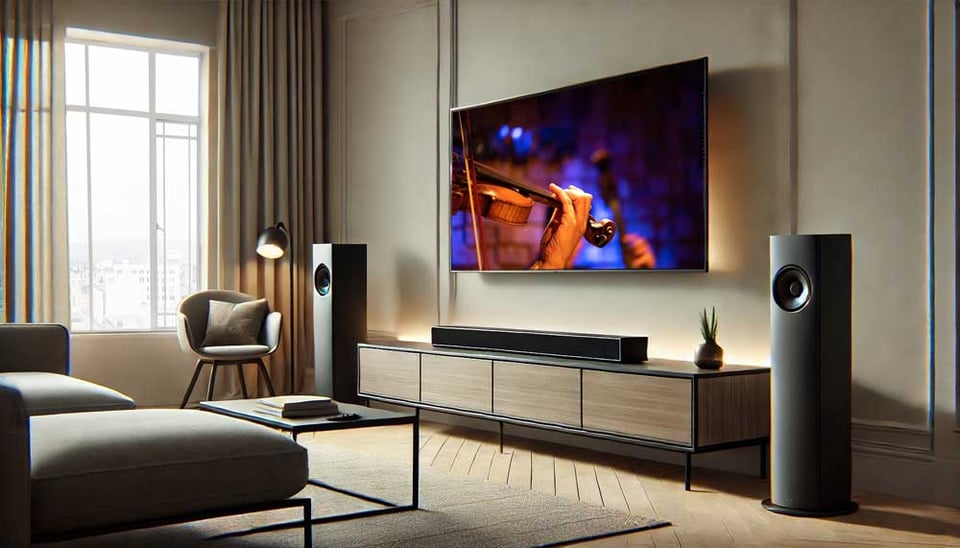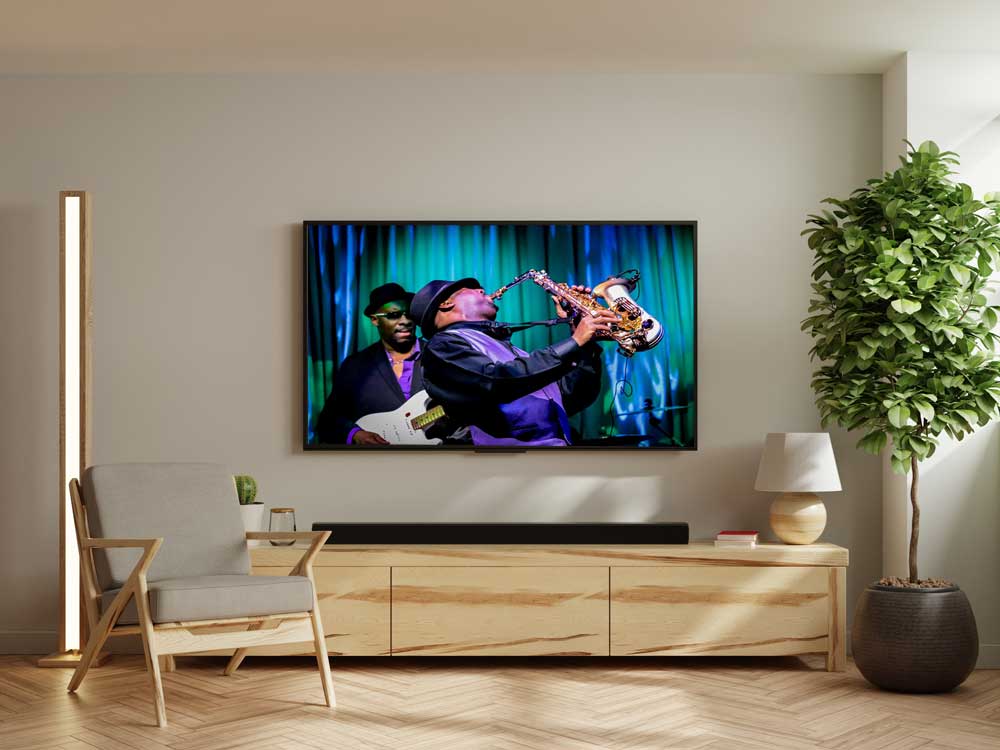Peak performance for HDMI soundbars

The home entertainment space has evolved significantly in recent years, with television displays becoming slimmer and more advanced, and a surge in consumer demand for immersive audio. As TV screens have become more visually impressive, their built-in speakers often fall short in delivering the depth, clarity, and richness of sound that audiences now expect. This gap has paved the way for the rise of the soundbar—a compact speaker solution that can simulate surround sound, integrate subwoofers, and even support advanced object-based audio formats.
For product developers tasked with creating soundbars, understanding the market’s current landscape is crucial. An essential component of soundbar design is connectivity, particularly via HDMI. Although optical, Bluetooth, and Wi-Fi connections remain popular, HDMI offers high-bandwidth capabilities and support for advanced formats. Moreover, the shift toward HDMI Audio Return Channel (ARC) and Enhanced Audio Return Channel (eARC) has redefined what’s possible in terms of audio quality, latency reduction, and ease of setup.
In this article, we will explore different types of soundbar connections, outline essential HDMI considerations, and discuss what product developers should keep in mind to ensure robust testing strategies for high-quality, reliable products.
The Soundbar Market
Soundbars bridge the gap between simple, low-fidelity TV speakers and complex, multi-speaker surround systems. They are designed to be user-friendly, requiring minimal setup while significantly enhancing audio quality. Three primary factors influence soundbar design and testing:
-
Form Factor
- Single-Bar Designs: These are compact units that house multiple speaker drivers. Some rely on a separate wireless subwoofer for bass reinforcement.
- Soundbases or Sound Platforms: These are broader, flatter devices intended to support a television’s weight. Though less popular than slender bars, they can deliver fuller sound due to their larger internal volume.
- Modular Soundbars: This category includes bars that allow add-ons, such as rear surround speakers or additional subwoofers, offering a more scalable surround experience.
-
Audio Formats
- Stereo vs. Multi-Channel: Many basic soundbars provide stereo or virtual surround. Higher-end models support Dolby Atmos or DTS:X for a more immersive experience.
- High-Resolution Audio: Some devices go beyond surround formats to handle high-bitrate audio, tapping into more niche audiophile markets.
-
Connectivity and Interaction
- Wireless Protocols: Bluetooth and Wi-Fi streaming (e.g., Chromecast, AirPlay) let users play audio from smartphones or home networks.
- HDMI & ARC/eARC: These are increasingly vital for delivering top-tier audio formats and minimizing cable clutter.
Soundbars have become especially relevant given modern consumers’ appetite for cinematic experiences in the comfort of their living rooms. For product developers, this translates into higher expectations for performance, ease of use, and robust connectivity.

Types of Soundbar Connections
Though some consumers still rely on older connections like optical (Toslink) or even 3.5mm analog, HDMI has emerged as the gold standard for both bandwidth and convenience.
Below is a brief overview of common connection types:
-
HDMI (ARC/eARC)
- ARC (Audio Return Channel): Allows audio to travel both to the TV and back from it, cutting down on cable clutter and simplifying setup. ARC supports most mainstream surround formats, though bandwidth can be limited.
- eARC (Enhanced Audio Return Channel): A more robust version of ARC, enabling advanced surround formats with higher bandwidth and minimal compression. This is essential for Dolby Atmos or DTS:X in their full resolution.
-
Optical (Toslink)
- Optical cables still offer decent quality but can’t handle the widest range of high-bitrate formats. Many entry-level soundbars include an optical port for broader compatibility.
- Optical cables still offer decent quality but can’t handle the widest range of high-bitrate formats. Many entry-level soundbars include an optical port for broader compatibility.
-
Bluetooth / Wi-Fi
- Bluetooth: Common for quick music playback from phones or tablets, but can introduce latency or compression artifacts.
- Wi-Fi (e.g., Chromecast, AirPlay): Better for multi-room audio and higher-quality streaming, yet reliant on network stability.
-
Ethernet / USB
- Less common for typical consumer use, but some advanced soundbars offer these for firmware updates or networking in professional or specialised settings.
When product developers consider these connection types, the goal is to ensure maximum compatibility with different TVs, streaming devices, and external sources. The more robust the connectivity, the less friction consumers face during setup and usage.
HDMI Considerations for Soundbars
HDMI remains central to modern soundbar design. Here’s what product developers should account for when dealing with HDMI integration:
-
Version Compatibility
- Different HDMI versions (e.g., HDMI 2.0, HDMI 2.1) offer varying levels of bandwidth and supported features. For instance, eARC is part of the HDMI 2.1 specification, although many manufacturers enable it on HDMI 2.0 chipsets with firmware updates. Ensuring correct implementation is key to device reliability.
- Different HDMI versions (e.g., HDMI 2.0, HDMI 2.1) offer varying levels of bandwidth and supported features. For instance, eARC is part of the HDMI 2.1 specification, although many manufacturers enable it on HDMI 2.0 chipsets with firmware updates. Ensuring correct implementation is key to device reliability.
-
ARC/eARC Implementations
- Adherence to eARC compliance tests ensures robust interoperability. If a TV and soundbar share eARC, they can handle high-bitrate formats without lossy compression. Developers must test how the soundbar behaves with a range of TVs and sources that might not uniformly implement eARC.
- Adherence to eARC compliance tests ensures robust interoperability. If a TV and soundbar share eARC, they can handle high-bitrate formats without lossy compression. Developers must test how the soundbar behaves with a range of TVs and sources that might not uniformly implement eARC.
-
Cable Quality
- While often overlooked, HDMI cable quality can affect signal integrity. Product developers should recommend or bundle certified cables with their soundbars to reduce support issues.
- While often overlooked, HDMI cable quality can affect signal integrity. Product developers should recommend or bundle certified cables with their soundbars to reduce support issues.
-
CEC (Consumer Electronics Control)
- HDMI CEC allows one remote to control multiple devices. Proper CEC implementation simplifies user experience but requires extensive testing for device compatibility. A mismatch in CEC commands can create a frustrating experience.
- HDMI CEC allows one remote to control multiple devices. Proper CEC implementation simplifies user experience but requires extensive testing for device compatibility. A mismatch in CEC commands can create a frustrating experience.
-
Pass-Through vs. Processing
- Some soundbars pass the video signal through HDMI to the TV. Developers must confirm the device’s internal video processing or pass-through capabilities don’t introduce visual artifacts or latency.
Audio Quality Considerations
High audio fidelity is the hallmark of a premium soundbar. Key factors include:
-
Frequency Response and Clarity
- Soundbars should reproduce the full frequency range—from bass notes in action movie soundtracks to the high-frequency details in orchestral music. Testing includes frequency response measurements to identify dips or peaks that could reduce clarity.
- Soundbars should reproduce the full frequency range—from bass notes in action movie soundtracks to the high-frequency details in orchestral music. Testing includes frequency response measurements to identify dips or peaks that could reduce clarity.
-
Subwoofer Integration
- Whether internal or external, subwoofers handle low frequencies that small drivers struggle with. The handshake between a soundbar and its subwoofer—wired or wireless—must be seamless. Developers should pay special attention to subwoofer pairing methods and potential interference.
- Whether internal or external, subwoofers handle low frequencies that small drivers struggle with. The handshake between a soundbar and its subwoofer—wired or wireless—must be seamless. Developers should pay special attention to subwoofer pairing methods and potential interference.
-
Surround Sound Immersion
- Many soundbars employ psychoacoustic techniques or side-firing drivers to create surround effects. Testing helps ensure these virtualization technologies work consistently across different content, from movies to music.
- Many soundbars employ psychoacoustic techniques or side-firing drivers to create surround effects. Testing helps ensure these virtualization technologies work consistently across different content, from movies to music.
-
Dolby Atmos and DTS:X
- Next-generation formats rely on object-based rendering, which can benefit from upward-firing drivers that bounce sound off ceilings to create a height dimension. Ensuring the bar’s design supports these configurations—while meeting customer expectations—is vital.
Testing Fundamentals for Product Developers
Reliability and consistency are critical for soundbar success. Below are the core testing areas:
-
Connectivity Testing
- Verify handshake reliability across different TV brands and HDMI generations.
- Assess ARC/eARC behaviour, ensuring stable audio return and correct decoding.
-
Latency Checks
- Delays between picture and sound degrade user experience. Developers should test for minimal lip-sync errors when connected via HDMI.
- Delays between picture and sound degrade user experience. Developers should test for minimal lip-sync errors when connected via HDMI.
-
Stress Tests and Edge Cases
- Evaluate how the soundbar responds to signal interruptions, hot-plug events, or cable swaps. This is where real-world usage can be simulated to prevent consumer complaints.
- Evaluate how the soundbar responds to signal interruptions, hot-plug events, or cable swaps. This is where real-world usage can be simulated to prevent consumer complaints.
-
Multi-Format Compatibility
- Confirm the device handles various codecs (Dolby Digital, DTS, AAC, etc.) seamlessly.
- Test for fallback scenarios: how does the soundbar behave if a legacy source device provides a format it can’t decode?
-
User Experience and Interface
- HDMI CEC commands, remote controls, and on-screen menus should be intuitive and bug-free.
Future Trends and Challenges
High-Bandwidth Streaming
As 4K and 8K content become commonplace, higher-bitrate audio follows suit. Soundbars must adapt to advanced HDMI features to handle future-proof audio. For developers, staying ahead of these standards is a strategic necessity.
Wireless Ecosystems
Many soundbars are part of multi-room wireless ecosystems, requiring robust Wi-Fi and streaming protocol integrations (e.g., AirPlay 2, Chromecast). The challenge is ensuring these systems align perfectly with HDMI-based connections.
AI and Voice Control
Voice assistants are integrating into soundbars, adding another layer of complexity to device design. Developers must manage the interplay of microphones, far-field voice recognition, and the device’s audio output.
Soundbar Success
For product developers, the current soundbar market offers immense opportunity and fierce competition. Success hinges on delivering both captivating audio quality and a streamlined user experience. HDMI connectivity—especially ARC/eARC—has become pivotal for ensuring that soundbars can handle modern audio formats while offering the simplicity that consumers demand.
Designing and testing for connectivity and audio quality requires a holistic approach: from verifying HDMI handshake reliability to optimising internal speaker configurations for the best acoustic performance. With proper diligence and comprehensive test strategies, developers can deliver soundbars that not only meet consumer expectations but also push the boundaries of immersive home audio.
Efficient HDMI Soundbar Testing Solutions from Nextgen
By establishing an integrated environment for HDMI soundbar testing, and especially utilising the latest automation platforms and test services, issues that might slow down time-to-market can be identified and fixed quickly and efficiently.
Ultimately, better product performance, and user experience saves businesses time and money and builds brand recognition. To find out more about HDMI soundbar testing using automation and advanced diagnostics, and Nextgen's global test and validation services please contact Nextgen or call +44 3331 120 000 or lets set up an online meeting.




